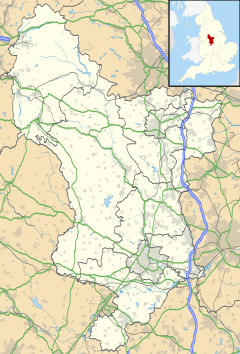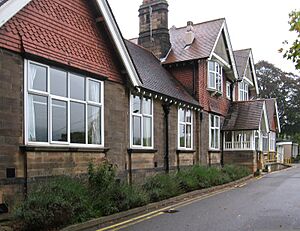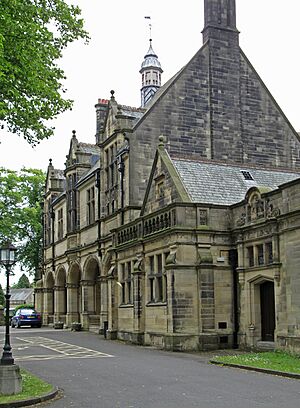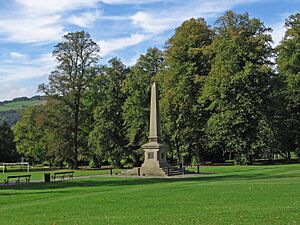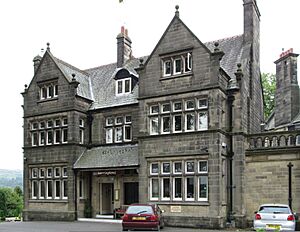Darley Dale facts for kids
Quick facts for kids Darley Dale |
|
|---|---|
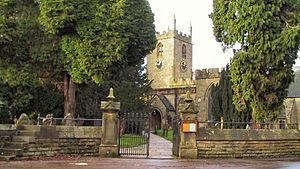 St. Helen's Church, Darley Dale |
|
| Population | 5,413 (Including Hackney. 2011) |
| OS grid reference | SK270632 |
| Civil parish |
|
| District |
|
| Shire county | |
| Region | |
| Country | England |
| Sovereign state | United Kingdom |
| Post town | MATLOCK |
| Postcode district | DE4 |
| Dialling code | 01629 |
| Police | Derbyshire |
| Fire | Derbyshire |
| Ambulance | East Midlands |
| EU Parliament | East Midlands |
| UK Parliament |
|
Darley Dale, once known simply as Darley, is a friendly town in Derbyshire, England. It's located in the beautiful Derbyshire Dales area, just north of Matlock. The town sits right by the River Derwent and the main A6 road. About 5,413 people live here, and it's part of a larger area that includes Matlock and Rowsley.
Contents
Exploring Darley Dale's Area
Darley Dale parish stretches for about 2 miles along the A6 road. It starts near the ARC Leisure Centre and goes up to Stancliffe Quarry. The River Derwent forms its border to the south-west. The area also includes hills and moors that reach as far as Darwin Forest Country Park to the north-east.
The parish is made up of several smaller places. These include Darley Dale itself, Darley Hillside, Churchtown, Two Dales (which used to be called Toadhole), Upper Hackney, and Farley. Sometimes, people get Darley Dale mixed up with Darley Abbey or Dale Abbey, but those are different places.
A Look Back at Darley Dale's History
Darley Dale has a long and interesting history.
- The beautiful St Helen's Church has been standing since the 12th century.
- Darley Bridge, which is still used today, was built way back in the 15th century.
- In the mid-1700s, two important turnpike roads opened. These were roads where you paid a fee to use them. One opened in 1759, and another in 1760.
- The railway arrived in 1849, bringing passenger trains to Darley Dale. This made travel much easier.
- A new railway station opened in 1873, and in 1890, it was officially named Darley Dale station.
- Around the same time, the area known as "Toadhole" got a nicer name: "Two Dales."
- The town grew a lot in the 1800s and 1900s. This was thanks to industries like lead mining, metal forging, the railway, and quarrying.
Places to Worship in Darley Dale
St Helen's Church
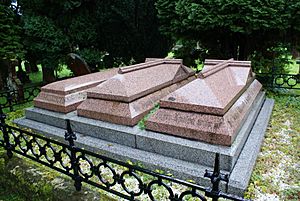
St Helen's Church is in the Churchtown part of Darley Dale. It's a very old church, built in the 12th century. It was fixed up in 1877, and its tower was made stronger in 1902–03. If you look at the outside, you can see different styles of building from different time periods.
Inside, there are memorials to important people like Sir John de Darley from the 14th century. There's also a special window for Sir Joseph Whitworth, a famous engineer who lived here and is buried in the churchyard. Just outside the church, there's a huge yew tree. People say it's 2,000 years old and has a trunk about 33 feet around! It's believed this tree was a special place even before Christianity.
Methodist Churches
Darley Dale has several Methodist churches with interesting histories.
- The Wesleyan Methodist Chapel on Chesterfield Road was built in 1827. It's now a home, but it used to be a bakery and a Sunday school.
- The Hackney Primitive Methodist Chapel was built in 1848. It's also no longer used for worship.
- The Dale Road Methodist Church was built in 1904 and is still in use.
- The Hackney Methodist Church was built in 1908. It has also become a private home.
- The Darley Hillside Methodist Church was built in 1912. It's now a community center.
The Amazing Whitworth Legacy
Sir Joseph Whitworth was a very important engineer from the 1800s. He lived in Darley Dale for the last 13 years of his life at Stancliffe Hall. He passed away in 1887 and is buried at St. Helen's Church. Sir Joseph had big plans for the village, and his wife, Lady Louisa, helped make them happen after he died. They wanted to make life better for the people of Darley Dale.
Whitworth Hospital
Lady Louisa Whitworth built the Whitworth Cottage Hospital. It opened in 1889 and was one of her first big projects. This hospital is still used today by the NHS. It helps people with minor injuries and offers other health services.
Whitworth Institute
The Whitworth Institute opened in 1890. This was Lady Louisa's second major project. It had an indoor swimming pool, a large hall, reading rooms, and later a library. There was also a billiard room, a natural history museum, and even a hotel (the Whitworth Hotel, now called "Barrington's"). The Institute was given to the people of Darley Dale. It was renovated in 2009/10 to make sure it can be used for many more years.
Whitworth Park
Whitworth Park is a fantastic place for sports and relaxation. It has fields for soccer and cricket, a bowling green, and a skateboard area. The park also has over ten acres of beautiful gardens with paths and a shallow lake. In the middle of the park, there's a tall monument called an obelisk that honors Sir Joseph Whitworth. The park was improved in 2003 with a £750,000 renovation.
Famous People from Darley Dale
Many interesting people have connections to Darley Dale:
- Nigel Bond, a professional snooker player, was born here.
- Tom Chambers, a well-known actor, was born in Darley Dale in 1977.
- Mike Hendrick, an English cricketer, was also born here in 1948.
- Christopher Green, a comedy writer and performer, grew up in the town.
- Joseph Paxton, a famous architect and gardener, worked at the nearby Chatsworth House.
- Joseph Whitworth, the engineer, whose legacy we just learned about.
Fun Things to See and Do
Darley Dale is a lively place with lots to offer!
- In 2003, the town won the 'Large Village' category in the Britain in Bloom competition for its beautiful flowers and gardens.
- Every two years, in July, there's the Darley Dale Arts Festival, celebrating local art and creativity.
- At the bottom of Station Road, you'll find Darley Dale railway station. While regular trains stopped in the 1960s, it's now home to Peak Rail. You can ride a heritage steam train from here to Matlock or Rowsley South.
- Every September, the Darley Dale Festival of Transport takes place, showcasing all kinds of vehicles.
- The holiday resort Darwin Forest Country Park is also nearby.
- The Square & Compass pub on Station Road hosts an annual Ale House Rocks Music Festival.
Two Dales (Once Called Toadhole)
The area now known as Two Dales was called "Toadhole" until the late 1800s! The local vicar suggested changing the name to help attract more visitors, just like "Dale" was added to Darley.
An old mill called Ladygrove Mill was built in Two Dales. It was first used for spinning cotton, then flax. The mill owners, Edward and James Dakeyne, built special dams and invented a unique "disc engine" to power their mill. This engine was very advanced for its time! Even though the mill is mostly gone, you can still see parts of the old dams.
The Plough Inn pub in Two Dales has a funny story connected to it. In 1946, famous English footballer Eddie Shimwell wanted to buy the pub. His team, Sheffield United, wouldn't let him because they didn't want players owning pubs. So, Eddie asked to be transferred and ended up playing for Blackpool!
Media
To keep up with local news, Darley Dale residents can watch BBC East Midlands and ITV Central. There are also local radio stations like BBC Radio Derby and Capital Midlands. You can read local newspapers such as the Matlock Mercury, Buxton Advertiser, and Derbyshire Times.
Images for kids
See also
 In Spanish: Darley Dale para niños
In Spanish: Darley Dale para niños


